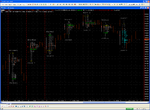This is my take:
I don't think it serves any purpose to discuss what makes an indicator and what doesn't. At the end of the day, we can split all of the information in the "market population" into two categories:
1) Information that arrives in the market from external sources (such as news, fundamentals etc)
2) Information that is generated by the market. At a granular level, the information generated by the market comes in a pretty raw format of time and sales.
Now, whether you are drawing an hourly bar chart, plotting a slow stochastic, building a market profile, a point and figure chart, or calculating the co-integration of two pharmacutical stocks, you are still analysing market generated information* for clues about the behaviour of assets in the market.
Some of the techniques used, such as calculating a 10 period RSI, IMO don't bear any relevance to the forces that are generating the information we are looking at. It's a bit like taking your long or short bias from the number of people sitting on the left of the bus vs. the right - sometimes you will end up trading the right way, other times you won't (it doesn't help when you get internet forums with 200,000 members all telling you that 10 period RSI is all you need, because you get psychological issues blurring your judgement). Other techniques however, do stand up to a bit of intelligent critique - cointegration, for example, is (or was) used by statistical arbitrage traders in the form of pair trades and similar strategies. In addition, I think you will find that people employing cointegration actually understand what the metrics they are using to support their decision making are - I doubt that all traders using RSI really understand what it is measuring, they will just describe it as an oscillator.
So, getting round to Market Profile specifically - does it stand up to an intelligent critique? Does the analysis Market Profile advocates bear any relevance to the forces that are generating the time and sales information that we are looking at? Well, if we break down MP to the most basic level, it is a technique that is used to help answer the question "where are the most deals being done?***" Is this a sensible question to be asking? Yes. Are the techniques that MP advocates appropriate for answering this question? Yes.
Q.E.D.
On a more practical level, I will add a couple of my experiences with MP; firstly, it tends to work better on some markets than others - markets that have a designated opening and closing time, and markets that have a high population of locals (usually because the locals are all using MP and so it becomes something of a self-fulfilling prophecy). Secondly, whether it is suited to the product you are trading or not, it has to suit your personal trading style if you are going to focus on using Market Profile as the driving factor behind your trading decisions.
* "Market Generated Information" is a term coined from the book Mind Over Markets, which describes the basics of Market Profile. Whether you use MP or not, I highly recommend it.
*** Although the original Market Profile was designed to work on 30m TPO's, I think you can count all "Volume @ Price" and similar techniques in the same bucket. Market Profile isn't the thing you pay $50 to the CBOT for, it's a way you look at the information you have. Moreover, Market Profile also references sources such as the CFTC report and the Liquidity Data Bank.
All IMO.




